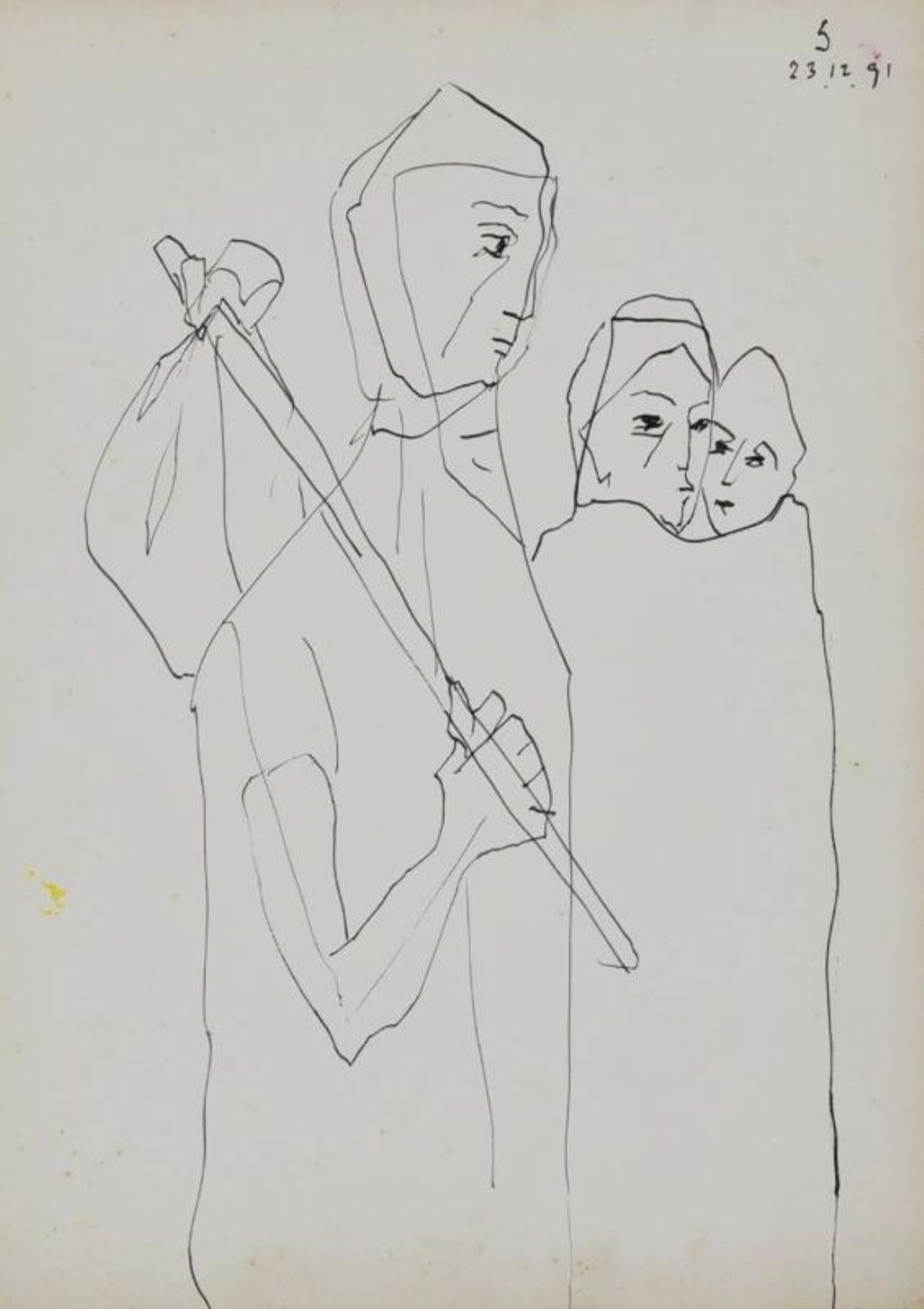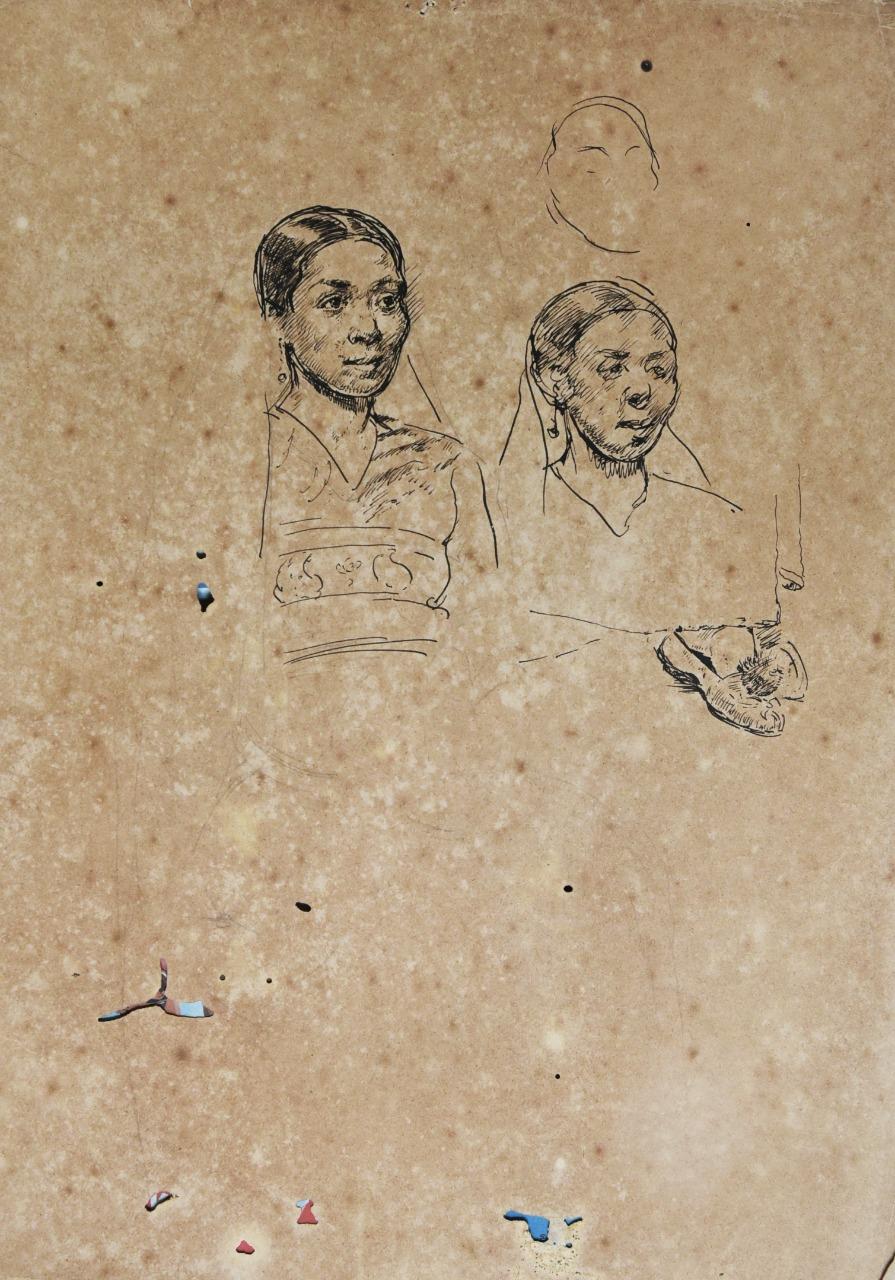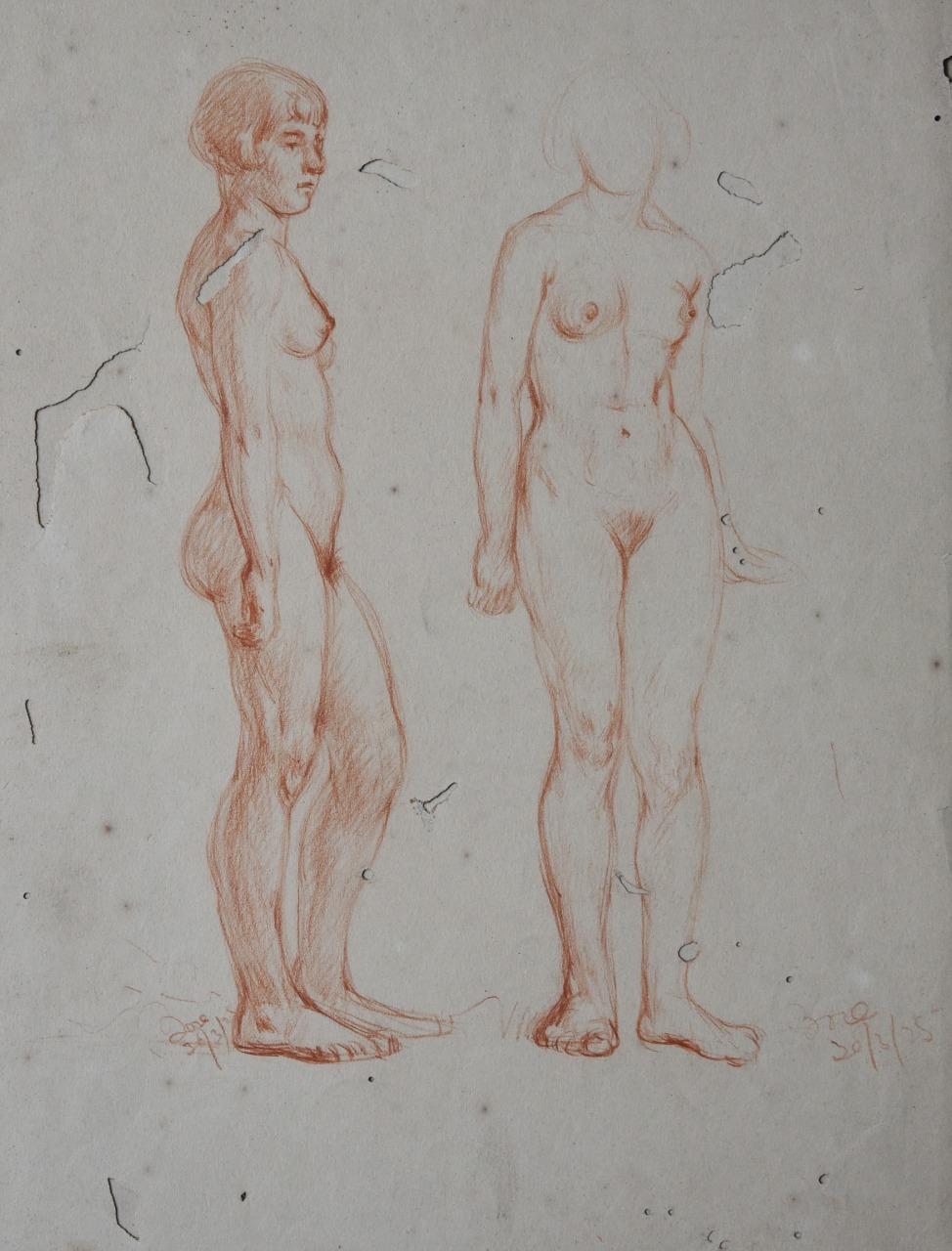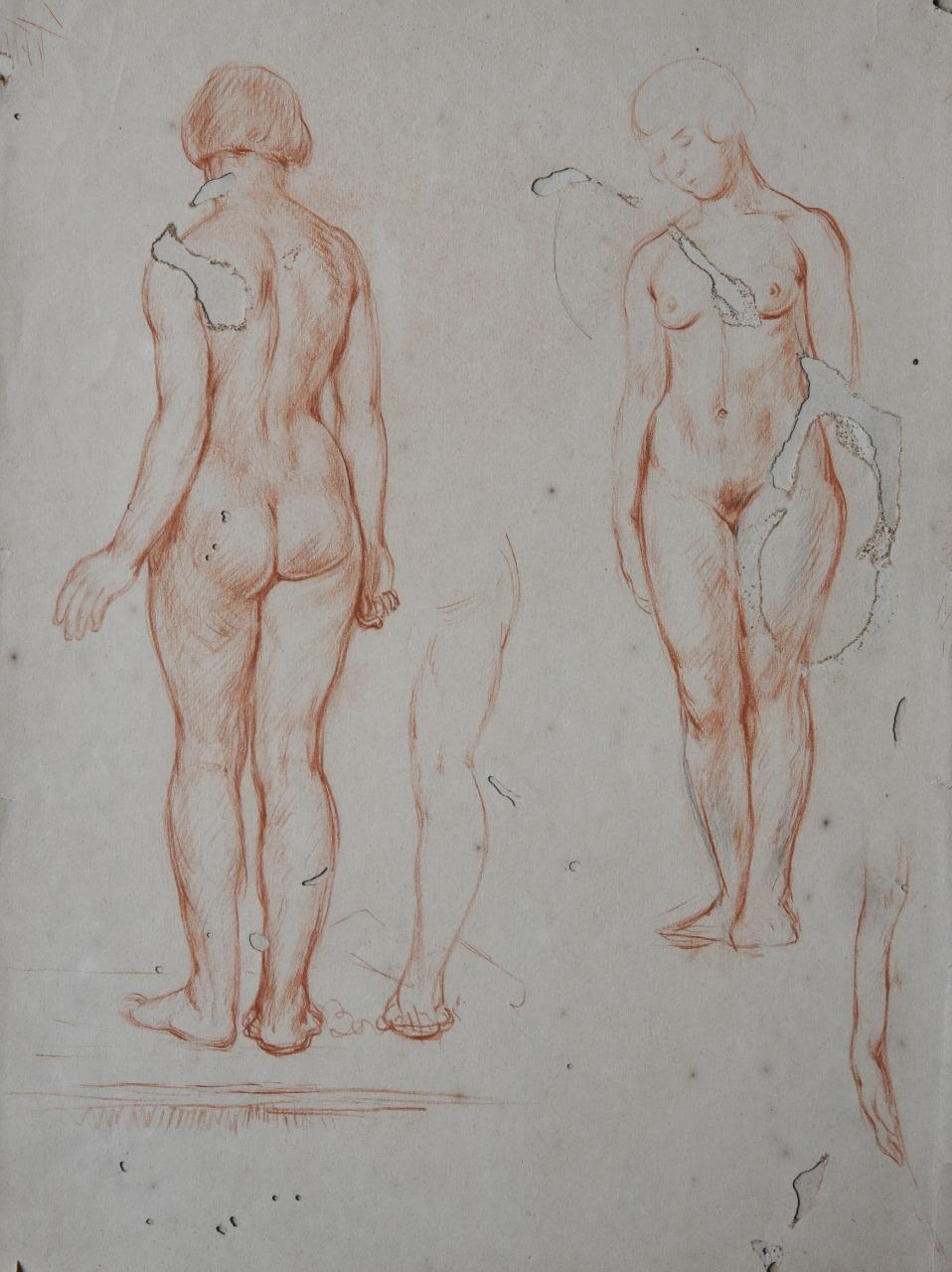M.F. HusainSets, Ink on Paper, Black & White by Indian Artist MF Husain “In Stock”1997
1997
About the Item
- Creator:M.F. Husain (1915 - 2011, Indian)
- Creation Year:1997
- Dimensions:Height: 11 in (27.94 cm)Width: 14 in (35.56 cm)Depth: 1 in (2.54 cm)
- Medium:
- Movement & Style:
- Period:
- Framing:Framing Options Available
- Condition:
- Gallery Location:Kolkata, IN
- Reference Number:1stDibs: LU60438438912
M.F. Husain
M.F. Husain was born in Pandharpur, Maharashtra to a Sulaymani Bohra family who traces their roots back to Gujarat within the last 200 years, and then originally to Yemen. Husain completed his art studies from Sir J.J. School of Art. His first serious work was exhibited by the Bombay Art Society in 1947, where he was invited to join five other painters in founding the Progressive Artists Group. Husain, who became known as the “Picasso of India,” created works that could be caustic and funny as well as serious and sombre. His themes—usually treated in series—included topics as diverse as Mohandas K. Gandhi, Mother Teresa, the Ramayana, the Mahabharata, the British Raj and motifs of Indian urban and rural life. M.F. Husain’s best known and the most controversial work is ‘Bharat Mata’ (Mother India) in which he portrays India as a red-colored nude woman with her arms and legs contorted into the shape of the Indian subcontinent. The painting led to an uproar of protests from organizations like Vishva Hindu Parishad (VHP) and was later sold for Rs 80 lakh in an auction. He also made ‘Gaja Gamini’ and ‘Meenaxi: A Tale of Three Cities’. The latter was screened and appreciated at the 2004 Cannes Film Festival. Husain, a secular Muslim, triggered criticism for his often irreverent treatment of the sensitive subject matter, including Hindu goddesses painted as nudes. Other significant works include Man (1951), Vishwamitra (1973), and Passage Through Human Space, a series of 45 watercolours completed in the mid-1970s.
- ShippingRetrieving quote...Ships From: Kolkata, India
- Return PolicyThis item cannot be returned.
- Untitled, Mixed Media on Paper, Black, Yellow colour by Modern Artist "In Stock"By Sakti BurmanLocated in Kolkata, West BengalSakti Burman (a) Untitled - 3 x 6 inches (Unframed size) Pen on Paper , 1992 (b) Untitled - 4.5 x 9 inches (Unframed size) Mixed Media on Paper , 1992 Framed & Door Deliver...Category
21st Century and Contemporary Modern Figurative Paintings
MaterialsInk, Paper, Mixed Media, Pen
- Family, Pen & Ink on Paper by Modern Indian Artist Somnath Hore "In Stock"By Somnath HoreLocated in Kolkata, West BengalSomnath Hore - Family Pen & Ink on Paper, 13.6 x 10 inches ; 1991 ( Unframed & Delivered ) Inclusive of shipment mounted not framed, Should you wish to receive the same framed and s...Category
1960s Modern Figurative Drawings and Watercolors
MaterialsInk, Paper
- Royal Academy Series-3, Pen & Ink on Paper, Modern Artist Atul Bose "In Stock"Located in Kolkata, West BengalAtul Bose - Royal Academy Series-3 Pen & Ink on Paper, 15 x 11.2 inches (Unframed Size) 1924-26 (Delivered Unframed in as is condition) Atul Bose was a master artist whose creative journey spanned several decades and left an indelible mark on the Indian art scene. He was born in 1898 in a small village in Bengal and showed an early aptitude for art. Despite facing financial difficulties, he pursued his passion and enrolled in the Government School of Art in Calcutta. Bose's early works were influenced by the Bengal School of Art, which was a movement that sought to revive traditional Indian art forms. However, over time, Bose developed his own unique style that blended elements of Indian art with European modernism. He was particularly influenced by the works of artists like Paul Cezanne and Georges Braque. Bose spent two years, 1924-6, at the Royal Academy. He was heavily influenced there by the post-impressionist Walter Sickert. He refused an invitation to help decorate the pavilion at the British Empire Exhibition in 1924 with Mukul Dey...Category
1920s Modern Figurative Drawings and Watercolors
MaterialsInk, Paper, Pen
- Royal Academy Series-4, Conte on Paper, Modern Artist Atul Bose "In Stock"Located in Kolkata, West BengalAtul Bose - Royal Academy Series-4 Conte on Paper, 15 x 11.2 inches (Unframed Size) 1924-26 (Delivered Unframed in as is condition) Atul Bose was a master artist whose creative journey spanned several decades and left an indelible mark on the Indian art scene. He was born in 1898 in a small village in Bengal and showed an early aptitude for art. Despite facing financial difficulties, he pursued his passion and enrolled in the Government School of Art in Calcutta. Bose's early works were influenced by the Bengal School of Art, which was a movement that sought to revive traditional Indian art forms. However, over time, Bose developed his own unique style that blended elements of Indian art with European modernism. He was particularly influenced by the works of artists like Paul Cezanne and Georges Braque. Bose spent two years, 1924-6, at the Royal Academy. He was heavily influenced there by the post-impressionist Walter Sickert. He refused an invitation to help decorate the pavilion at the British Empire Exhibition in 1924 with Mukul Dey...Category
1920s Modern Figurative Drawings and Watercolors
MaterialsInk, Conté, Paper, Pen
- Royal Academy Series-3, Pen & Ink on Paper, Modern Artist Atul Bose "In Stock"Located in Kolkata, West BengalAtul Bose - Royal Academy Series-3 Pen & Ink on Paper, 15 x 11.2 inches (Unframed Size) 1924-26 (Delivered Unframed in as is condition) Atul Bose was a master artist whose creative journey spanned several decades and left an indelible mark on the Indian art scene. He was born in 1898 in a small village in Bengal and showed an early aptitude for art. Despite facing financial difficulties, he pursued his passion and enrolled in the Government School of Art in Calcutta. Bose's early works were influenced by the Bengal School of Art, which was a movement that sought to revive traditional Indian art forms. However, over time, Bose developed his own unique style that blended elements of Indian art with European modernism. He was particularly influenced by the works of artists like Paul Cezanne and Georges Braque. Bose spent two years, 1924-6, at the Royal Academy. He was heavily influenced there by the post-impressionist Walter Sickert. He refused an invitation to help decorate the pavilion at the British Empire Exhibition in 1924 with Mukul Dey...Category
1920s Modern Figurative Drawings and Watercolors
MaterialsPen, Ink, Paper
- Royal Academy Series-4, Conte on Paper, Modern Artist Atul Bose "In Stock"Located in Kolkata, West BengalAtul Bose - Royal Academy Series-4 Conte on Paper, 15 x 11.2 inches (Unframed Size) 1924-26 (Delivered Unframed in as is condition) Atul Bose was a master artist whose creative journey spanned several decades and left an indelible mark on the Indian art scene. He was born in 1898 in a small village in Bengal and showed an early aptitude for art. Despite facing financial difficulties, he pursued his passion and enrolled in the Government School of Art in Calcutta. Bose's early works were influenced by the Bengal School of Art, which was a movement that sought to revive traditional Indian art forms. However, over time, Bose developed his own unique style that blended elements of Indian art with European modernism. He was particularly influenced by the works of artists like Paul Cezanne and Georges Braque. Bose spent two years, 1924-6, at the Royal Academy. He was heavily influenced there by the post-impressionist Walter Sickert. He refused an invitation to help decorate the pavilion at the British Empire Exhibition in 1924 with Mukul Dey...Category
1920s Modern Figurative Drawings and Watercolors
MaterialsInk, Conté, Paper, Pen
- Americana Farmer and Wife, Gouache Painting WPA Art William Gropper WoodchopperBy William GropperLocated in Surfside, FLWilliam Gropper Original Gouache on Paper depicting man carrying an axe and woman carrying basket walking together. Hand signed lower right Fra...Category
Mid-20th Century Modern Figurative Paintings
MaterialsInk, Watercolor, Gouache
- Americana, Lawyer in Court, Politician, Gouache Painting WPA Art William GropperBy William GropperLocated in Surfside, FLWilliam Gropper Original Gouache on Paper Hand signed lower right 33.5 x 27.5 image 26 x 20.5 The New-York born artist William Gropper was a painter and cartoonist who, with caricature style, focused on social concerns, and was actively engaged in support of the organized labor movement throughout his career. This original watercolor drawing is done in the iconic style of the artist's oeuvre. Born to Harry and Jenny Gropper in 1897, William was raised in New York City's Lower East Side. His parents were Jewish immigrants from Romania and Ukraine, and young William grew up in relative poverty, watching his family struggle to achieve that sought-after American dream. His father, a bright and college-educated man, was unable to find employment that worthy of his intellect. His mother, meanwhile, worked as a seamstress from home. Coupled with the devastating loss of an aunt to the infamous Triangle Factory fire of 1911, significant childhood factors created the foundation that led to Gropper’s exploration of the American experience. Early on, Gropper displayed an extraordinary, natural skill for art. By 1912, he was already studying under the instruction of George Bellows and Robert Henri at the Ferrer School in Greenwich Village. During his time at school, Gropper was also awarded a prestigious scholarship to study at the National Academy of Design. However, he refused to fit into convention and was swiftly expelled from the Academy. After his expulsion, Gropper returned home to help financially by assisting his mother and taking a shop position. However, he didn't abandon art academia and soon presented a portfolio to the New York School of Fine Art which earned him a scholarship for study. Gropper obtained his first significant job as a cartoonist for the New York Tribune in 1917. While working as a staff cartoonist for the Tribune, he also contributed drawings to publications like Vanity Fair, New Masses, The Nation, and Freiheit. His interest in the welfare of the American worker, class inequality, and social injustice was central in his work. After publishing the graphic novel Alley Oop in 1930, Gropper's illustration career extended well into the decade. However, he was never exempt from controversy, and his 1935 Vanity Fair cartoon; prompted anger from the Japanese government. As an involved labor organizer and Social Realist activist, Gropper continued to bring attention to his radical reputation with visits to the Soviet Union and Poland. However, his concern with European politics and U.S. social causes didn't slow down his artistic career, and by the late 1930s, he had produced significant murals for American cities like Washington D.C. His 1938 mural Construction of a Dam was commissioned for the Department of the Interior and represents the Social-Realism style that depicts experiences of the worker and everyday societal life. Measuring at a staggering 27ft by 87ft, the piece portrays muscular, robust American laborers scaling rocky hillsides, building infrastructure, and operating heavy machinery. The mural feels undeniably American with golden scenery, denim blues, and steely gray colors. Gropper fits perfectly into Social-Realism because the style exhibits an illustrative flair with strong lines and simple, bold hues. The inspiration for Construction of a Dam sprang from his 1937 travels to the poverty-stricken Dust Bowl area. The trip was sponsored by a Guggenheim Foundation Fellowship, and his drawings of the Grand Coulee and Boulder Dams...Category
Mid-20th Century Modern Figurative Paintings
MaterialsInk, Watercolor, Gouache
- "Men at the Seattle Public Market" (Two Figures)By Mark TobeyLocated in Missouri, MOMark Tobey "Men at the Seattle Public Market" (Two Figures) 1958 Ink and Tempera on Silk Signed and Dated Lower Left *This is a rare and important work. See attached images with book...Category
Mid-20th Century Modern Figurative Paintings
MaterialsInk, Tempera, Silk
- Scroll painting of the American ship commanded by Commodore Matthew PerryLocated in Amsterdam, NLAttributed to Ukita Ikkei (1795-1859) Hanging scroll painting of the American ship commanded by Commodore Matthew Perry in Uraga Bay, annotate...Category
Mid-19th Century Edo Figurative Drawings and Watercolors
MaterialsInk, Paper
- Yangliuqing Longevity New Year Painting, c. 1920Located in Chicago, ILChinese New Year paintings (nian hua) are colorful folk paintings created to celebrate the annual Spring Festival. Drawn or printed by folk artists in regional studios, nian hua pain...Category
Early 20th Century Folk Art Figurative Paintings
MaterialsInk, Pigment, Paper
- Yangliuqing Peace & Prosperity New Year Painting, c. 1920Located in Chicago, ILChinese New Year paintings (nian hua) are colorful folk paintings created to celebrate the annual Spring Festival. Drawn or printed by folk artists in regional studios, nian hua paintings featured exaggerated characters with bright and contrasting colors. Put up around the home to beckon luck and happiness in the coming year, most paintings depicted mythical guardians, scenes from folk operas, or auspicious symbols of good luck. This New Year painting depicts a young woman holding a vase filled with peony blossoms. This combination of motifs is a visual idiom for "may you have peace and prosperity" (ping'an fu gui). The early 20th century painting is from the town of Yangliuqing, one of the leading producers of traditional New Year's paintings known for its combination of woodblock printing...Category
Early 20th Century Folk Art Figurative Paintings
MaterialsPaper, Ink, Pigment






